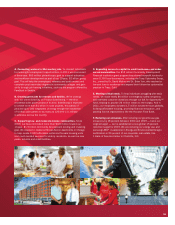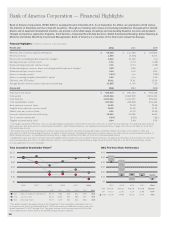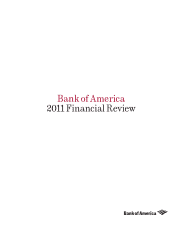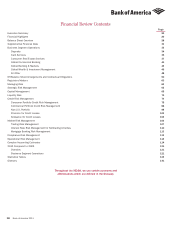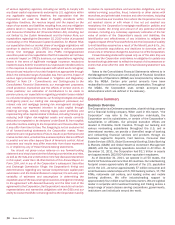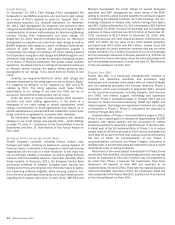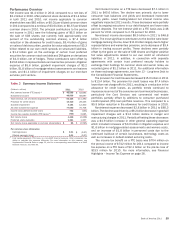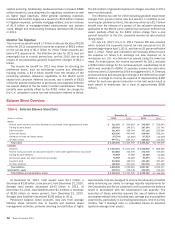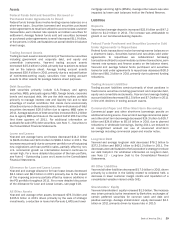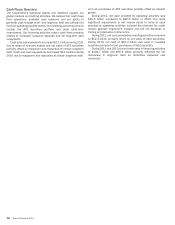Bank of America 2011 Annual Report Download - page 25
Download and view the complete annual report
Please find page 25 of the 2011 Bank of America annual report below. You can navigate through the pages in the report by either clicking on the pages listed below, or by using the keyword search tool below to find specific information within the annual report.Bank of America 2011 23
Private-label Securitization Settlement with the Bank of
New York Mellon
On June 28, 2011, the Corporation, BAC Home Loans Servicing,
LP (BAC HLS, which was subsequently merged with and into Bank
of America, N.A. (BANA) in July 2011), and its legacy Countrywide
affiliates entered into a settlement agreement with BNY Mellon,
as trustee (Trustee), to resolve all outstanding and potential claims
related to alleged representations and warranties breaches
(including repurchase claims), substantially all historical loan
servicing claims and certain other historical claims with respect
to 525 legacy Countrywide first-lien and five second-lien non
government-sponsored enterprise (GSE) residential mortgage-
backed securitization trusts (the Covered Trusts) containing loans
principally originated between 2004 and 2008 for which BNY
Mellon acts as trustee or indenture trustee (the BNY Mellon
Settlement). The BNY Mellon Settlement agreement is subject to
final court approval and certain other conditions.
An investor opposed to the settlement removed the proceeding
to the U.S. District Court for the Southern District of New York. On
October 19, 2011, the district court denied BNY Mellon’s motion
to remand the proceeding to state court. BNY Mellon and the
Investor Group petitioned to appeal the denial of this motion and
on December 27, 2011, the U.S. Court of Appeals for the Second
Circuit accepted the appeal and stated in an amended scheduling
order that, pursuant to statute, it would decide the appeal by
February 27, 2012. On November 4, 2011, the district court
entered a written order setting a discovery schedule, and discovery
is ongoing.
It is not currently possible to predict how many of the parties
who have appeared in the court proceeding will ultimately object
to the BNY Mellon Settlement, whether the objections will prevent
receipt of final court approval or the ultimate outcome of the court
approval process, which can include appeals and could take a
substantial period of time. In particular, the conduct of discovery
and the resolution of the objections to the settlement and any
appeals could also take a substantial period of time and these
factors, along with the removal of the proceedings to federal court
and the associated appeal, could materially delay the timing of
final court approval. Accordingly, it is not possible to predict when
the court approval process will be completed.
For additional information about the BNY Mellon Settlement,
see Off-Balance Sheet Arrangements and Contractual Obligations
– Representations and Warranties on page 50, Off-Balance Sheet
Arrangements and Contractual Obligations – Other Mortgage-
related Matters on page 57 and Note 9 – Representations and
Warranties Obligations and Corporate Guarantees to the
Consolidated Financial Statements. For more information about
the risks associated with the BNY Mellon Settlement, see Item
1A. Risk Factors of this Annual Report on Form 10-K.
Capital Related Matters
We continued to sell certain business units and assets as part of
our capital management and enterprise-wide initiatives. In
November 2011, we sold an aggregate of approximately 10.4
billion common shares of China Construction Bank Corporation
(CCB) through private transactions with investors resulting in an
aggregate pre-tax gain of $2.9 billion. We currently hold
approximately one percent of the outstanding common shares of
CCB. The sale also generated approximately $2.9 billion of Tier 1
common capital and reduced our risk-weighted assets by $4.9
billion under Basel I, strengthening our Tier 1 common capital ratio
by approximately 24 basis points (bps).
In December 2011, we sold our Canadian consumer card
portfolio strengthening our Tier 1 common capital ratio by
approximately seven bps.
In November and December 2011, we entered into separate
agreements with certain institutional preferred and trust preferred
security holders to exchange shares, or depositary shares
representing fractional interests in shares, of various series of our
outstanding preferred stock, or trust preferred or hybrid income
term securities of various unconsolidated trusts, as applicable,
with an aggregate liquidation preference of $5.8 billion for 400
million shares of our common stock and $2.3 billion aggregate
principal amount of our senior notes. In connection with the
exchanges of trust preferred securities, we recorded gains of $1.2
billion. The exchanges in aggregate resulted in an increase of $3.9
billion in Tier 1 common capital and increased our Tier 1 common
capital ratio approximately 29 bps under Basel I. For additional
information regarding these exchanges, see Note 13 – Long-term
Debt and Note 15 – Shareholders’ Equity to the Consolidated
Financial Statements.
Overall during 2011, we generated 126 bps of Tier 1 common
capital and reduced risk-weighted assets by $172 billion, including
as a result of, among other things, the exchanges of preferred
stock and trust preferred or hybrid securities, our sales of CCB
shares and the $5.0 billion investment in preferred stock and
common stock warrant by Berkshire Hathaway, Inc. (Berkshire).
For additional information on the Berkshire investment, see Note
15 – Shareholders’ Equity to the Consolidated Financial
Statements.
As credit spreads for many financial institutions, including the
Corporation, have widened during the past year due to global
uncertainty and volatility, the market value of debt previously
issued by financial institutions has decreased. This uncertainty in
the market, evidenced by, among other things, volatility in credit
spreads, makes it economically advantageous to consider
purchasing and retiring certain of our outstanding debt
instruments. In 2012, we completed a tender offer to purchase
and retire certain subordinated notes for approximately $3.4 billion
in cash and will consider additional purchases in the future
depending upon prevailing market conditions, liquidity and other
factors. If the purchase of any debt instruments is at an amount
less than the carrying value, such purchases would be accretive
to earnings and capital.
We intend to continue to build capital through retaining
earnings, actively reducing legacy asset portfolios and
implementing other capital related initiatives, including focusing
on reducing both higher risk-weighted assets and assets currently
deducted, or expected to be deducted under Basel III, from capital.
We expect non-core asset sales to play a less prominent role in
our capital strategy in future periods. We issued approximately
122 million of immediately tradable shares of common stock, or
approximately $1.0 billion (after-tax) to certain employees in
February 2012 in lieu of a portion of their 2011 year-end cash
incentive. We may engage, from time to time, in privately negotiated
transactions involving the issuance of common stock, cash or other
consideration in exchange for preferred stock and certain trust
preferred securities in amounts that are not expected to be
material to us, either individually or in the aggregate.




